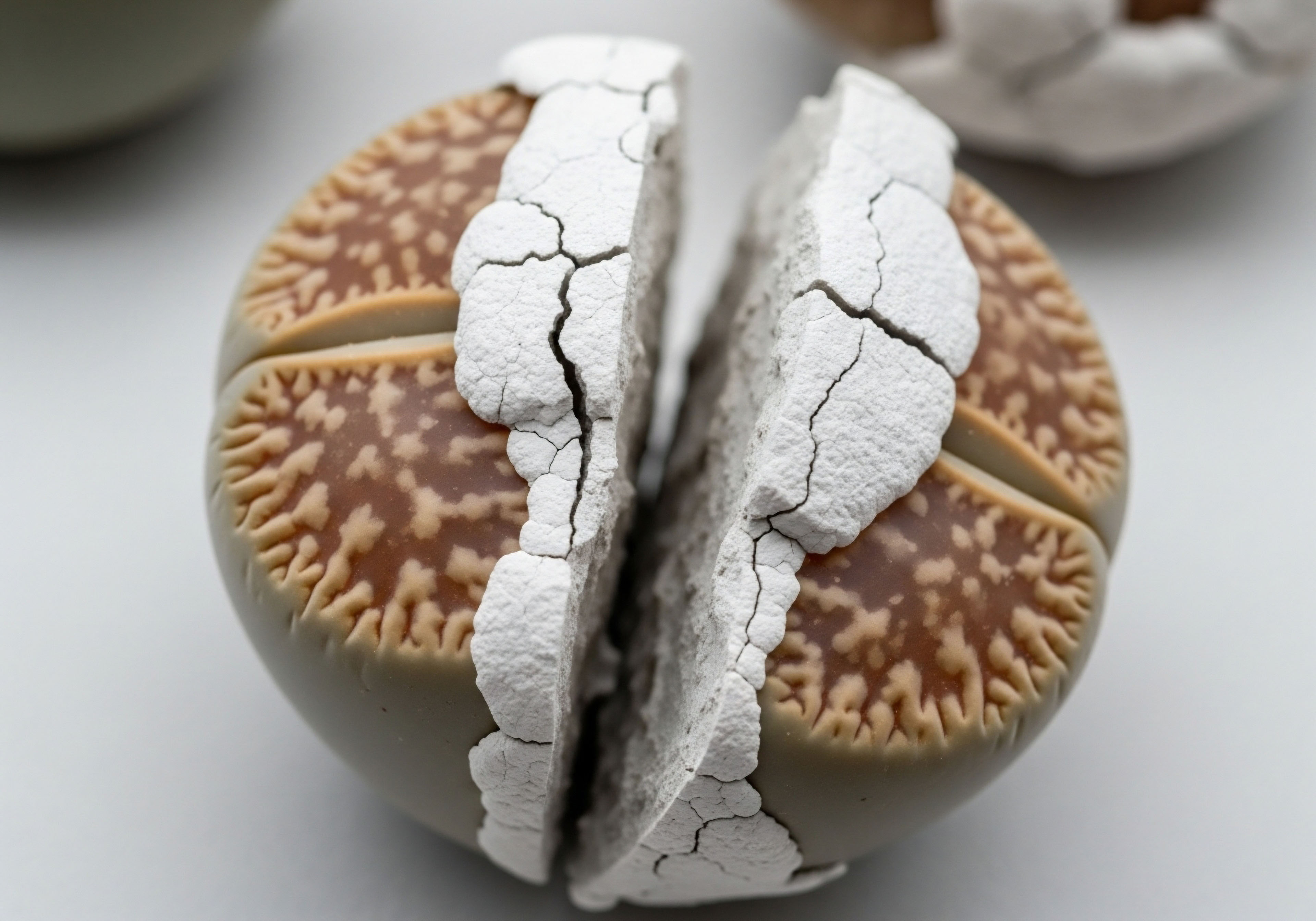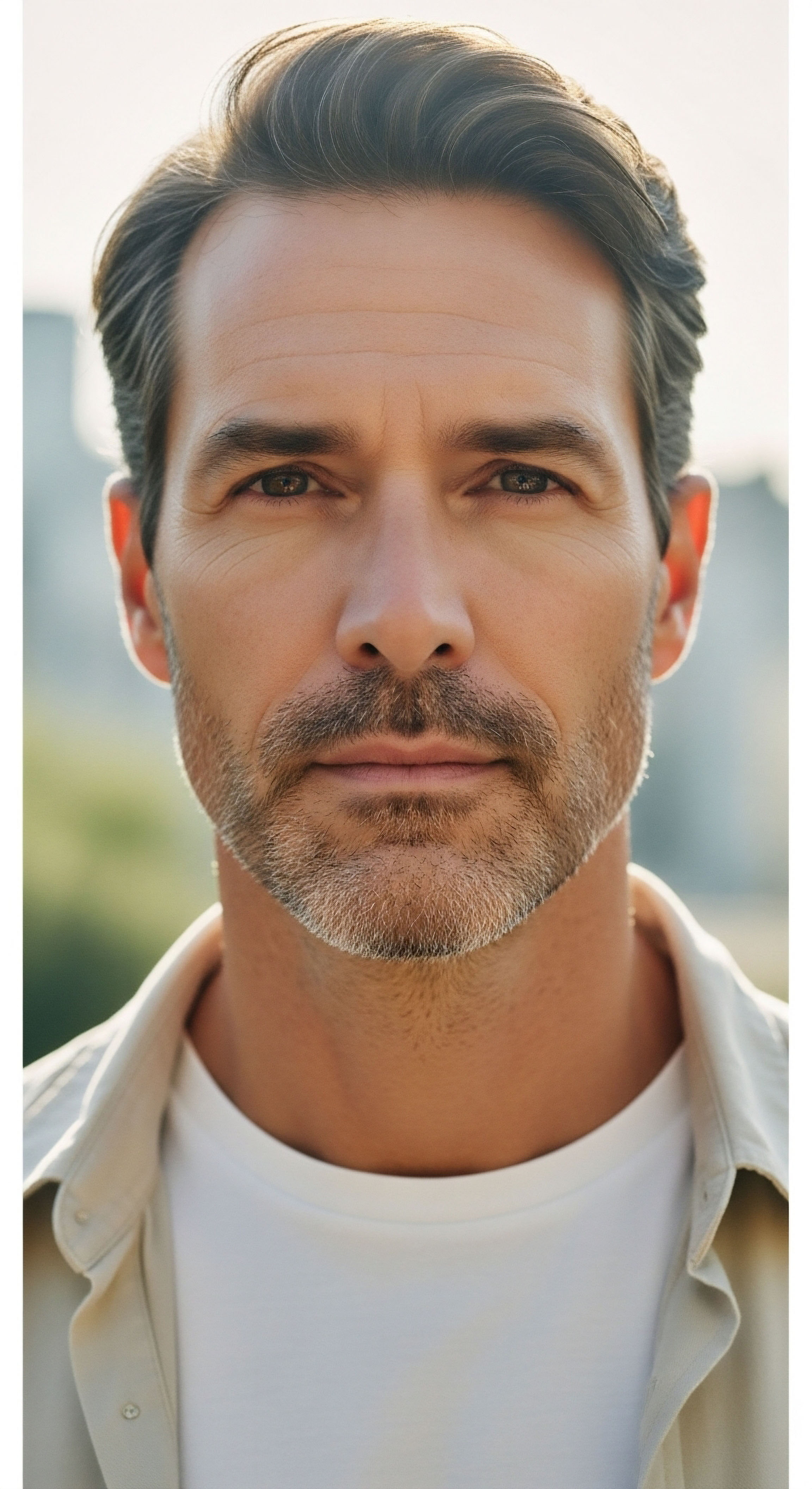

Fundamentals
You may have first noticed it in the shower drain, on your pillow, or in the bristles of your hairbrush. It is a subtle shift, a change in the texture and density of your hair that feels deeply personal. This experience, the quiet observation of your body changing, is a valid and important starting point.
Your hair, in many ways, is a visible manifestation of your internal health, a sensitive barometer reflecting the complex symphony of your body’s hormonal communication. Understanding its changes is the first step toward reclaiming a sense of control and vitality. The journey begins by learning to interpret this biological language, connecting what you see and feel on the outside to the precise, powerful signals operating within.
At the very core of hair’s existence is the hair follicle, a remarkable, self-renewing micro-organ embedded within the skin. Each follicle operates on a distinct, cyclical timeline, a process that dictates the life of every single strand on your head. This is the hair growth cycle, and it consists of three primary phases.
The anagen phase is the period of active growth, where cells in the follicle’s base divide rapidly to build the hair shaft. This phase can last for several years, determining the maximum length your hair can achieve.
Following this is the catagen phase, a brief transitional period lasting only a few weeks, where the hair follicle shrinks and detaches from its blood supply. The final stage is the telogen phase, a resting period of several months, at the end of which the old hair is shed to make way for a new one beginning its anagen phase.
The thickness, density, and overall health of your hair are directly dependent on the length and robustness of the anagen phase and the seamless transition between these cycles.
Your hair’s appearance is a direct reflection of the health and timing of the follicular growth cycle, which is governed by internal hormonal signals.
This meticulously organized cycle is regulated by a host of signaling molecules, with hormones acting as the primary conductors. These chemical messengers travel through your bloodstream, delivering instructions that profoundly influence the behavior of your hair follicles. The main hormonal players in this context are estrogens, progesterone, and androgens. Each carries a unique set of instructions that can either support or disrupt hair growth, and their balance is key to maintaining healthy hair.

The Key Hormonal Influencers
Estrogens, particularly estradiol, are powerful allies to your hair. They work to prolong the anagen (growth) phase of the hair cycle. By keeping follicles in this active state for longer, estrogen contributes to longer, thicker, and more resilient hair strands.
When estrogen levels are optimal, a greater percentage of your hair follicles are actively growing at any given time, resulting in a fuller appearance and a healthy sheen. This is why many women experience their best hair during pregnancy, when estrogen levels are exceptionally high.
Progesterone is another significant female hormone that influences the hair cycle. Its role is complex, and its effects can be dose-dependent. Optimal levels of progesterone can help to counterbalance the effects of androgens, but significant fluctuations or the use of certain synthetic progestins can sometimes disrupt the cycle and contribute to shedding. Its primary impact is often seen in its relationship with estrogen and androgens, acting as a modulating influence within the broader endocrine system.
Androgens are a group of hormones that include testosterone and its more potent derivative, dihydrotestosterone (DHT). While testosterone is often associated with male characteristics, it is also present and vital for both men’s and women’s health, contributing to libido, bone density, and muscle mass. In the context of hair, testosterone’s role is paradoxical.
It supports the growth of body hair, yet on the scalp, its conversion to DHT can be detrimental. DHT is the primary molecule responsible for a condition known as androgenetic alopecia, or pattern hair loss. It binds to receptors in genetically susceptible hair follicles and triggers a process called miniaturization. This process progressively shortens the anagen phase and shrinks the follicle, causing the hair it produces to become finer, shorter, and lighter until it eventually stops growing altogether.

Understanding Hormonal Optimization Protocols
Hormone replacement therapy, or more accurately, hormonal optimization, is a clinical strategy designed to restore these crucial signaling molecules to more youthful and functional levels. The goal is to alleviate symptoms associated with hormonal decline, such as those experienced during menopause in women or andropause in men.
Because hormones have such a widespread impact, these protocols can affect everything from mood and energy levels to metabolic health and, of course, the appearance of your hair. The effect of any protocol on hair thickness and shine is entirely dependent on which hormones are being supplemented, the dosage, and the individual’s unique physiology and genetic predispositions.
A protocol that restores estrogen in a postmenopausal woman will have a very different effect on hair than one designed to increase testosterone in a man with hypogonadism. Each approach must be understood through the lens of its specific hormonal target and its mechanism of action at the level of the hair follicle.


Intermediate
Moving beyond foundational concepts, we can begin to examine the specific clinical protocols used in hormonal optimization and their direct impact on hair health. These are not one-size-fits-all solutions; they are precise interventions designed to recalibrate the body’s endocrine system.
The way these protocols influence hair thickness and shine is a direct consequence of how they alter the balance of key hormones and their interactions at the follicular level. Understanding the “how” and “why” of these treatments is essential for anyone considering them as part of their wellness journey.

Protocols for Female Hormonal Balance
For women navigating the complexities of perimenopause and post-menopause, hormonal shifts are the primary driver of changes in hair quality. The decline in estrogen is particularly significant. As circulating estrogen levels fall, the hair follicle’s anagen phase shortens, and the telogen phase may lengthen. This results in increased shedding and a gradual thinning of the hair over time. The hair strands themselves may become finer and more brittle.
A common protocol for symptomatic women involves the replacement of bioidentical estradiol, often administered through transdermal creams, patches, or pellets. By restoring circulating estrogen to more youthful levels, this therapy can help to re-extend the anagen phase of the hair follicle cycle.
The clinical objective is to keep a higher percentage of follicles in the active growth stage, which can lead to reduced shedding, improved hair density, and a return of thickness and luster over several months. Progesterone is also a key component of these protocols, particularly for women who still have a uterus, as it protects the uterine lining.
Bioidentical progesterone is typically preferred over synthetic progestins, as some synthetic versions can have androgenic properties that may negatively impact hair by mimicking the effects of DHT. The goal is a balanced restoration that mirrors the body’s natural hormonal environment as closely as possible.

The Role of Testosterone in Female Protocols
A growing area of clinical practice involves the use of low-dose testosterone for women, particularly to address symptoms like low libido, fatigue, and cognitive fog. Typically administered as weekly subcutaneous injections of Testosterone Cypionate (e.g. 10-20 units or 0.1-0.2ml) or via pellet therapy, this intervention can also have positive effects on hair.
Testosterone can contribute to a sense of overall vitality that is reflected in healthier-looking hair. However, its use requires careful management. Because testosterone can be converted into DHT by the enzyme 5-alpha reductase, there is a potential risk of triggering or exacerbating hair thinning in women who are genetically predisposed to androgenetic alopecia.
Clinicians often monitor for any signs of this and may adjust dosages accordingly. For some women, the benefits of optimized testosterone levels, when carefully balanced with estrogen and progesterone, create a systemic environment that is highly supportive of healthy hair growth.
A well-designed hormonal protocol for women aims to restore estrogen’s protective effect on the hair’s growth phase while using progesterone and testosterone to create overall systemic balance.
The table below outlines the general effects of key hormones on scalp hair, providing a clearer picture of their individual roles.
| Hormone | Primary Effect on the Hair Follicle | Impact on Hair Appearance |
|---|---|---|
| Estradiol | Prolongs the anagen (growth) phase of the hair cycle. | Promotes thickness, density, and may increase shine. |
| Progesterone | Modulates the effects of androgens and estrogen. Can help inhibit 5-alpha reductase activity. | Supportive of a healthy growth cycle when in balance. |
| Testosterone | Supports overall systemic health and vitality. Can be converted to DHT. | Can contribute to healthy hair, but poses a risk of thinning if DHT conversion is high. |
| DHT (Dihydrotestosterone) | Binds to androgen receptors in susceptible follicles, causing miniaturization and shortening the anagen phase. | The primary driver of pattern hair thinning and loss. |

Protocols for Male Hormonal Optimization
For men experiencing the symptoms of andropause or hypogonadism, Testosterone Replacement Therapy (TRT) is a standard and effective protocol. The primary goal is to restore testosterone levels to an optimal range, improving energy, mood, cognitive function, libido, and muscle mass. However, the impact of TRT on hair is a significant consideration, representing a clinical paradox that must be actively managed.
A standard TRT protocol often involves weekly intramuscular injections of Testosterone Cypionate (e.g. 200mg/ml). While restoring testosterone is beneficial for overall health, this increase in substrate provides more raw material for the 5-alpha reductase enzyme to convert into DHT. For men with a genetic predisposition to male pattern baldness, this can accelerate hair loss. A comprehensive and well-managed TRT protocol anticipates this issue and incorporates ancillary medications to create a balanced system.
- Anastrozole ∞ This medication is an aromatase inhibitor. The aromatase enzyme converts testosterone into estrogen. In men, managing estrogen levels is crucial to prevent side effects like water retention and gynecomastia. By controlling this conversion, Anastrozole helps maintain the proper testosterone-to-estrogen ratio, which is part of a healthy systemic environment. It is typically taken as a low-dose oral tablet twice per week.
- Gonadorelin ∞ This peptide is used to stimulate the pituitary gland, helping to maintain the body’s own natural testosterone production and testicular function. It mimics the action of Gonadotropin-Releasing Hormone (GnRH) and supports the Hypothalamic-Pituitary-Gonadal (HPG) axis. This is often administered as a subcutaneous injection twice per week.
- Managing DHT ∞ For men concerned about hair loss, a physician may also discuss the use of a 5-alpha reductase inhibitor like Finasteride. This medication specifically blocks the conversion of testosterone to DHT, directly addressing the primary mechanism of androgenetic alopecia. This allows the man to receive the systemic benefits of testosterone optimization while mitigating the specific risk to his hair follicles.
This multi-faceted approach demonstrates that effective hormonal optimization is about creating a finely tuned internal environment. The goal is to elevate the target hormone while simultaneously managing its conversion into other metabolites, ensuring a holistic improvement in well-being that includes, whenever possible, the preservation or enhancement of hair health.


Academic
A deep analysis of hormonal influence on hair requires a shift in perspective, from the systemic to the cellular. The hair follicle is not merely a passive recipient of hormonal signals; it is a dynamic, self-contained endocrine organ. Within this microscopic environment, hormones are synthesized, metabolized, and exert their effects through complex intracellular signaling cascades.
Understanding how hormonal optimization protocols affect hair thickness and shine necessitates an examination of these molecular mechanisms, particularly the interplay between sex steroids, their receptors, and the growth factors that govern follicular destiny.

The Follicle as a Local Steroidogenic Factory
The cells of the hair follicle, particularly those of the dermal papilla (DP) and the outer root sheath (ORS), possess the enzymatic machinery to create and modify steroid hormones. This concept of intracrinology, where a cell both produces and responds to its own hormones, is central to hair biology.
For instance, the enzyme aromatase, which converts androgens like testosterone into estradiol, is present in the ORS cells. This means the follicle can create its own protective estrogenic environment, locally modulating the influence of circulating androgens. Similarly, the enzyme 5-alpha reductase, which converts testosterone into the far more potent DHT, is highly active in the DP cells of follicles in androgen-sensitive areas like the scalp and beard. This local conversion is the pivotal event in androgenetic alopecia.
Hormonal optimization therapies directly alter the substrate available for these follicular enzymes. A TRT protocol in a male patient increases the amount of testosterone arriving at the DP, providing more raw material for 5-alpha reductase to generate DHT. Conversely, an estrogen-based protocol in a female patient increases circulating estradiol, which then binds to estrogen receptors (ERs) within the follicle.
There are two main types of estrogen receptors, ERα and ERβ, and their activation generally promotes cell proliferation and survival, contributing to the maintenance of the anagen phase. Progesterone’s role at this level is also significant; it can compete with androgens for certain enzymes and may help to downregulate androgen receptor expression, providing a moderating influence.

Gene Regulation and the Androgen Receptor Cascade
What happens after DHT binds to its androgen receptor (AR) in a dermal papilla cell? This binding event initiates a conformational change in the AR, causing it to translocate into the cell’s nucleus. Inside the nucleus, the DHT-AR complex acts as a transcription factor, binding to specific DNA sequences known as androgen response elements (AREs) on target genes.
This action alters the expression of those genes, changing the protein signals the DP cell sends to the surrounding keratinocytes of the hair matrix.
In genetically susceptible follicles, this signaling cascade is disruptive. The DP begins to secrete factors that shorten the anagen phase and initiate a premature entry into catagen. One such factor is Transforming Growth Factor-beta 2 (TGF-β2).
Androgens have been shown to upregulate TGF-β2, which is a potent inhibitor of epithelial cell growth and induces apoptosis (programmed cell death), effectively telling the follicle to stop growing. Over successive cycles, this process leads to the physical shrinking, or miniaturization, of the entire follicular apparatus.

The Growth Factor Connection What Is the Role of IGF-1
The actions of sex hormones are often mediated by or interconnected with local growth factors. One of the most critical of these in hair biology is Insulin-Like Growth Factor-1 (IGF-1). IGF-1 is a potent mitogen, meaning it stimulates cell proliferation, and it is a powerful survival factor, protecting cells from apoptosis.
It is known to be one of the most important factors in prolonging the anagen phase. Dermal papilla cells from healthy, non-balding scalp follicles secrete significantly higher levels of IGF-1 compared to cells from balding follicles.
This is where the systems-biology perspective becomes essential. The regulation of IGF-1 provides a direct link between sex hormone protocols and the growth hormone (GH) axis. Androgens themselves can influence IGF-1 expression in the dermal papilla. Furthermore, circulating IGF-1 levels are largely determined by GH secreted from the pituitary gland.
Pathologies of the GH/IGF-1 axis demonstrate its importance for hair ∞ individuals with Laron syndrome, a form of dwarfism caused by a defective GH receptor and resulting in extremely low IGF-1 levels, typically have sparse, thin hair.
This connection illuminates the mechanism behind another class of wellness protocols ∞ Growth Hormone Peptide Therapy. Peptides such as Sermorelin and Ipamorelin/CJC-1295 are secretagogues, meaning they stimulate the patient’s own pituitary gland to produce and release GH. This elevation in GH leads to a subsequent rise in systemic and local IGF-1 levels.
By increasing the amount of IGF-1 available to the hair follicle’s dermal papilla, these peptide protocols may directly support a more robust anagen phase. They work to counteract the miniaturization process by promoting the very growth signals that are suppressed by the DHT-AR cascade.
This demonstrates a sophisticated, multi-system approach to creating an internal environment conducive to healthy hair growth, moving beyond just the sex hormones to influence the broader network of growth factors that ultimately dictate cellular behavior.
The following table details the molecular interactions at the heart of hormonal influence on hair follicles.
| Molecular Component | Location in Follicle | Function & Role in Hormonal Pathways |
|---|---|---|
| 5-alpha reductase | Dermal Papilla, Sebaceous Gland | Enzyme that converts Testosterone to the more potent Dihydrotestosterone (DHT). |
| Aromatase | Outer Root Sheath | Enzyme that converts Androgens to Estrogens (e.g. Testosterone to Estradiol). |
| Androgen Receptor (AR) | Dermal Papilla Cells | Binds with DHT, translocates to the nucleus, and alters gene expression, leading to follicle miniaturization. |
| Estrogen Receptor (ER) | Dermal Papilla, Keratinocytes | Binds with Estradiol, generally promoting signals that prolong the anagen (growth) phase. |
| IGF-1 | Secreted by Dermal Papilla | A critical growth factor that promotes cell proliferation and survival, extending the anagen phase. Its production is influenced by both GH and local androgens. |
| TGF-β2 | Secreted by Dermal Papilla | An inhibitory growth factor upregulated by the DHT-AR complex. It promotes premature entry into the catagen (regression) phase. |

References
- Thornton, M. J. et al. “The prenatal morphogenesis of hair follicles depends upon a precisely regulated series of molecular genetic processes.” Experimental Gerontology, vol. 38, no. 1-2, 2003, pp. 1-13.
- Randall, V. A. “Androgens and hair growth.” Dermatologic Therapy, vol. 21, no. 5, 2008, pp. 314-328.
- Ohnemus, U. et al. “Hair follicle as an estrogen target and source.” Endocrine Reviews, vol. 27, no. 6, 2006, pp. 677-706.
- Grymowicz, M. et al. “Hormonal Effects on Hair Follicles.” International Journal of Molecular Sciences, vol. 21, no. 15, 2020, p. 5342.
- Stevenson, S. et al. “The Biology and Genomics of Human Hair Follicles ∞ A Focus on Androgenetic Alopecia.” Journal of Clinical Medicine, vol. 10, no. 18, 2021, p. 4149.
- Weger, N. and T. Schlake. “IGF-I signaling in the hair follicle.” Journal of Investigative Dermatology, vol. 125, no. 5, 2005, pp. 843-851.
- Van Scott, E.J. and R.P. Ekel. “Geometric variations in the cross section of human hair.” Journal of Investigative Dermatology, vol. 35, 1960, pp. 281-287.
- Philpott, M.P. et al. “Human hair growth in vitro.” Journal of Cell Science, vol. 97, no. 3, 1990, pp. 463-471.
- Itami, S. et al. “Mechanism of action of androgen in dermal papilla cells.” Annals of the New York Academy of Sciences, vol. 642, 1991, pp. 385-395.
- Su, H.Y. et al. “Insulin-like growth factor 1 and hair growth.” Dermatology Online Journal, vol. 5, no. 2, 1999, p. 1.

Reflection

Calibrating Your Internal Blueprint
The information presented here offers a map, a detailed guide to the intricate biological landscape that connects your hormonal status to the health of your hair. You have seen how the hair follicle operates as a sensitive, responsive system, listening intently to the chemical messages delivered by your endocrine network.
You now possess the vocabulary to understand this dialogue ∞ the language of anagen and telogen, of estrogens and androgens, of cellular receptors and growth factors. This knowledge is powerful. It transforms the passive experience of observing a symptom into the active process of understanding a system.
This understanding is the foundational step. The true path to personalized wellness is one of collaboration, a partnership between your lived experience and clinical expertise. Your personal health narrative, combined with objective data from laboratory testing and the guidance of a knowledgeable practitioner, creates a complete picture.
The purpose of this deep exploration is to equip you for that conversation, to empower you to ask precise questions and to recognize that you are the central figure in your own health story. The ultimate goal is a state of functioning where your internal biology and your external vitality are in full alignment, allowing you to operate with clarity and strength in every aspect of your life.



